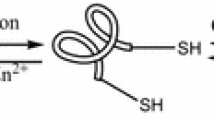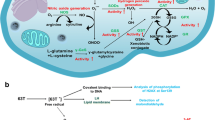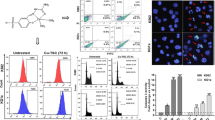Abstract
The combination of cytotoxic copper–thiosemicarbazone complexes with phenoxazines results in an up to 50-fold enhancement in the cytotoxic potential of the thiosemicarbazone against the MCF-7 human breast adenocarcinoma cell line over the effect attributable to drug additivity—allowing minimization of the more toxic copper–thiosemicarbazone component of the therapy. The combination of a benzophenoxazine with all classes of copper complex examined in this study proved more effective than combinations of the copper complexes with related isoelectronic azines. The combination approach results in rapid elevation of intracellular reactive oxygen levels followed by apoptotic cell death. Normal fibroblasts representative of non-cancerous cells (MRC-5) did not display a similar elevation of reactive oxygen levels when exposed to similar drug levels. The minimization of the copper–thiosemicarbazone component of the therapy results in an enhanced safety profile against normal fibroblasts.











Similar content being viewed by others
References
Peña MO, Lee J, Thiele DJ (1999) J Nutr 129(7):1251–1260
Evans GW (1973) Physiol Rev 53(3):535–570
Kouremenou-Dona E, Dona A, Papoutsis J, Spiliopoulou C (2006) Sci Total Environ 359(1–3):76–81
Kuo HW, Chen SF, Wu CC, Chen DR, Lee JH (2002) Biol Trace Elem Res 89:1–11
Gupte A, Mumper RJ (2009) Cancer Treat Rev 35(1):32–46
Gupta SK, Shukla VK, Vaidya MP, Roy SK, Gupta S (1991) J Surg Oncol 46:178–181
Buettner GR, Jurkiewicz BA (1996) Radiat Res 145:532–541
Schumaker PT (2006) Cancer Cell 10(3):175–176
Ma B, Goh BC, Tan EH, Lam KC, Soo R, Leong SS, Wang LZ, Mo F, Chan AT (2008) Investig New Drug 26(2):169–173
Kalinowski DS, Richardson DR (2005) Pharmacol Rev 57(4):547–583
Whitnall M, Howard J, Ponka P, Richardson DR (2006) Proc Natl Acad Sci USA 103(40):14901–14906
Jansson PJ, Sharpe PC, Bernhardt PV, Richardson DR (2010) J Med Chem 53(15):5759–5769
Lovejoy DB, Jansson PJ, Brunk U, Wong J, Ponka P, Richardson DR (2011) Cancer Res 71(17):5871–5880
Kalinowski DS, Jansson PJ, Kovacevic Z, Richardson DR (2013) Redox Rep 18(2):48–50
Gaál A, Orgován G, Polgári Z, Réti A, Mihucz VG, Bősze S, Szoboszlai N, Streli C (2014) J Inorg Biochem 130:52–58
Hancock CN, Stockwin LH, Han B, Divelbiss RD, Jun JH, Malhotra SV, Hollingshead MG, Newton DL (2011) Free Rad Biol Med 2011, 50(1) 110-121
Stefani C, El-Eisawi Z, Jansson PJ, Kalinowski DS, Richardson DR (2015) J Inorg Biochem 152:20–37
Giles GI (2006) Curr Pharm Design 12(34):4427–4443
Tew KD, Townsend DM (2011) Curr Opin Chem Biol 15(1):156–161
Kalinina E, Chernov N, Saprin A (2008) Biochemistry- Moscow 73(13):1493–1510
Nolan KA, Zhao H, Faulder PF, Frenkel AD, Timson DJ, Siegel D, Ross D, Burke TR Jr, Stratford IJ, Bryce RA (2007) J Med Chem 50(25):6316–6325
Li R, Bianchet MA, Talalay P, Amzel LM (1995) Proc Natl Acad Sci USA 92(19):8846–8850
Van Rensburg C, Van Staden A, Anderson R (1993) Cancer Res 53(2):318–323
Van Rensburg C, Anderson R, O’Sullivan J (1997) Crit Rev Oncol Hemat 25(1):55–67
Akladios FN, Andrew SD, Parkinson CJ (2015) Bioorg. Med. Chem. 23:3097–3104
Crossley ML, Turner RJ, Hofmann CM, Dreisbach PF, Parker RP (1952) J Am Chem Soc 74(3):578–584
Kalinowski DS, Yu Y, Sharpe PC, Islam M, Liao Y-T, Lovejoy DB, Kumar N, Bernhardt PV, Richardson DR (2007) J Med Chem 50(15):3716–3729
Richardson DR, Sharpe PC, Lovejoy DB, Senaratne D, Kalinowski DS, Islam M, Bernhardt PV (2006) J Med Chem 49(22):6510–6521
Lovejoy DB, Richardson DR (2002) Blood 100(2):666–676
Brown CA, West DX (2003) Transit Metal Chem 28(2):154–159
Chou T-C (2010) Cancer Res 70(2):440–446
Tütem E, Apak R, Baykut F (1991) Analyst 116:89–94
Cobine PA, Pierrel F, Bestwick ML, Winge DR (2006) J Biol Chem 281:36552–36559
Samuni Y, Goldstein S, Dean OM, Berk M (2013) Biochim Biophys Acta 1830:4117–4129
Zheng J, Lou JR, Benbrook DM, Hanigan MH, Lind SE, Ding W-Q (2010) Cancer Lett 298:186–194
Saito M, Kobayashi M, Iwabuchi S, Morita Y, Takamura Y, Tamiya E (2004) J Biochem 136(6):813–823
Wlodkowic D, Skommer J, Darzynkiewicz Z (2009) Methods Mol Biol 559: 10.1007/978-1-60327-017-5_2
Acknowledgements
We wish to acknowledge the contribution of Dr Gregg Maynard for assistance in setting up flow cytometry studies. F Akladios acknowledges the receipt of an Australian Postgraduate Award (APA). CJP wishes to thank the CSU Pharmacy Foundation for a grant partially funding this study. CJP and SDA thank the Kolling Institute (Royal North Shore Hospital) for the donation and characterization of the MCF-7 cell line employed in this study and Dr N Proschogo (University of Sydney) for the provision of mass spectrometry expertise.
Author information
Authors and Affiliations
Corresponding author
Electronic supplementary material
Below is the link to the electronic supplementary material.
Rights and permissions
About this article
Cite this article
Akladios, F.N., Andrew, S.D. & Parkinson, C.J. Increased generation of intracellular reactive oxygen species initiates selective cytotoxicity against the MCF-7 cell line resultant from redox active combination therapy using copper–thiosemicarbazone complexes. J Biol Inorg Chem 21, 407–419 (2016). https://doi.org/10.1007/s00775-016-1350-2
Received:
Accepted:
Published:
Issue Date:
DOI: https://doi.org/10.1007/s00775-016-1350-2




